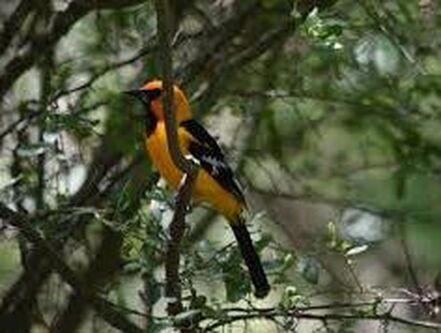Orioles - in Belize
Baltimore Oriole
Baltimore Oriole - Males are stunning, orange with black head. Females vary from yellowish to bright orange below with grayish head. Blue-gray bill is sharply pointed. Often found high in deciduous trees in open woodlands, forest edges, orchards, riversides, parks, and backyards. Rich, whistling song, echoes from treetops. Phrases vary, but rich quality of whistled notes is always the same. Visits feeders with nectar and fruits. Sometimes hybridizes with Bullock's Oriole.
BELIZE HABITAT - Sub-canopy and canopy; broadleaf forest interior and edge; open areas with scattered trees. In migration, also in second-growth scrub and roadside brush. Frequents flowering and fruiting trees. Where can you find this bird in Belize? Common transient and winter visitor, early September to mid-May. |
Orange Oriole
Orange Oriole - Large bright orange oriole with thick dark bill, found in open shrubby woodland. Limited black on face and throat; black back and wings with white wingbar and orange shoulder patch. Young birds duller yellow. Most similar to Hooded Oriole but larger and stockier with orange shoulder patch and thicker bill. Song is a series of sweet, clear whistles like many other orioles, but slower with a more deliberate, even pattern. Visits fruit feeders.
BELIZE HABITAT - Midlevels to sub-canopy; deciduous and semi-deciduous forest edge and open areas with scattered trees. Where can you find this bird in Belize? Small population resident in northeast Corozal; a few also on Ambergris Caye, but apparently only in winter October to April. |
Hooded Oriole
Hooded Oriole - Adult males are orange with black throat, black tail, and white patch on shoulder. Females dull yellow with grayer back, nape, and flanks than Orchard. Immature males similar to females, but with black throat. Often in parks, neighborhoods and near fan palms. Visits feeders with nectar and fruits. Bit smaller and longer-tailed than Baltimore and Bullock's Oriole. Slightly decurved bill. Variable color intensity; some birds richer orange, some more yellow.
BELIZE HABITAT - Open areas with scattered trees, especially palms and flowering and fruiting trees. Where can you find this bird in Belize? Common resident on mainland south to northeast Stann Creek and west to central Orange Walk and northeast Cayo, locally or irregularly west to San Ignacio. Common resident on larger cayes south to the Turneffe Islands. |
Orchard Oriole
Orchard Oriole
BELIZE HABITAT - Low level to canopy; broadleaf and pine forest edge; open areas with scattered trees, second growth scrub, and fallow fields, including rice fields. Frequents flowering and fruiting trees. Where can you find this bird in Belize? Uncommon (cayes) to very common (mainland) transient and common winter visitor, early August to late April. Peak numbers pass through from late August to mid-September and again in early April. |
Altamira Oriole
Altamira Oriole - Large bright orange oriole with thick dark bill, found in open shrubby woodland. Limited black on face and throat; black back and wings with white wingbar and orange shoulder patch. Young birds duller yellow. Most similar to Hooded Oriole but larger and stockier with orange shoulder patch and thicker bill. Song is a series of sweet, clear whistles like many other orioles, but slower with a more deliberate, even pattern. Visits fruit feeders.
BELIZE HABITAT - Midlevels to canopy; broadleaf forest edge, open areas with scattered trees. Where can you find this bird in Belize? Uncommon to fairly common resident on mainaland south locally to east Orange Walk and north Belize; occasionally to north Cayo and south Belize. Also recorded on Ambergris Caye, mostly in winter. |
Black-Cowled Oriole
Black Cowled Oriole - Attractive black-and-yellow oriole of humid tropical lowlands. Favors forest edge, plantations, semi-open areas with tall hedges and flowering trees. Often in flowering trees with other species of orioles. Plumage rather variable, but note the rather small, slightly decurved bill. Male has black head and back in Mexico and northern Central America, female has black face and greenish back. Sexes look alike in southern Central America. Not especially vocal.
BELIZE HABITAT - Midlevels to canopy; broadleaf, pine, and palm forest interior and edge; open areas with scattered trees, especially coconut palms. Where can you find this bird in Belize? Common resident on mainland and north Ambergris Caye; absent from the other cayes. |
Yellow-Tailed Oriole
Yellow Tailed Oriole - Flashy black-and-yellow oriole of humid tropical lowlands. Favors tangles and thickets along rivers and near water, also overgrown fields. Usually in pairs, often rather skulking. Both sexes have black back and wings with a big yellow shoulder bar, black tail with yellow sides that flash in flight. Immature has same pattern but duller, with a greenish back. Rich whistled song has a rollicking, rhythmic cadence.
BELIZE HABIAT - Midlevels to canopy; broadleaf forest edge, often along edges of streams; less often, open areas with scattered trees around towns and villages. Where can you find this bird in Belize? Fairly common to locally common resident on mainland. |
Yellow-Backed Oriole
Yellow Backed Oriole - Attractive black-and-yellow oriole. Mainly in pine-oak forest of highlands, but also in humid tropical lowlands of Yucatan Peninsula. Often in flowering trees with other species of orioles. Both sexes have a yellow head and body with a small black mask and throat patch, black wings and tail. Bill is straight and pointed. Richly whistled and slightly halting song carries well.
BELIZE HABIAT - Midlevels to canopy; primarily in pines, but also locally in open broadleaf forest and forest edge. Where can you find this bird in Belize? Locally fairly common on mainland nearly throughout, but absent from northwest Corozal, north Orange Walk, Vaca Plateau, Maya Mountains, and all but north east Toledo; Common on Ambergris Caye, but absent from other cayes. |









